AES New York 2018
Paper Session P13
P13 - Acoustics and Live Sound
Friday, October 19, 1:15 pm — 4:15 pm (1E11)
P13-1 A Quiet Zone System, Optimized For Large Outdoor Events, Based on Multichannel FxLMS ANC—Daniel Plewe, Technical University of Denmark - Kgs. Lyngby, Denmark; Finn T. Agerkvist, Technical University of Denmark - Kgs. Lyngby, Denmark; Jonas Brunskog, Technical University of Denmark - Kgs. Lyngby, Denmark
As part of the bigger EU project MONICA (Horizon2020) a local quiet zone system is being developed. This system provides a zone of quiet close to loud outdoor concerts in order to support communications or minimize the noise exposure of staff. Because the noise sources are the loudspeakers of the venue’s PA system an ideal reference signal can be obtained from the sound engineer’s mixing console, which can be used to apply methods of feedforward active noise control. This paper presents a real time application of the multichannel filtered reference least mean square algorithm (MCFxLMS), shows how it has been designed, implemented and tested under laboratory conditions.
Convention Paper 10104 (Purchase now)
P13-2 Advancements in Propagation Delay Estimation of Acoustic Signals in an Audience Service for Live Events—Marcel Nophut, Leibniz Universität Hannover - Hannover, Germany; Robert Hupke, Leibniz Universität Hannover - Hannover, Germany; Stephan Preihs, Leibniz Universität Hannover - Hannover, Germany; Jürgen Peissig, Leibniz Universität Hannover - Hannover, Germany
In the course of the project PMSE-xG an audience service for live events – the Assistive Live Listening Service – was developed. The service uses supplementary augmented audio content presented through transparent headphones to enhance the traditional audio playback of a PA loudspeaker system. Augmented audio content and ambient sound are temporally aligned by the service. This paper proposes signal processing techniques to improve existing methods for estimating the propagation delay of acoustic signals in strongly reverberant environments. These refined methods aim to reduce the computational costs and allow the service to keep track of moving listeners. The proposed methods are evaluated based on realistic recordings of music and speech samples.
Convention Paper 10105 (Purchase now)
P13-3 Perceptual Evaluation of an Augmented Audience Service under Realistic Live Conditions—Robert Hupke, Leibniz Universität Hannover - Hannover, Germany; Marcel Nophut, Leibniz Universität Hannover - Hannover, Germany; Stephan Preihs, Leibniz Universität Hannover - Hannover, Germany; Jürgen Peissig, Leibniz Universität Hannover - Hannover, Germany
With the usage of future 4G+/5G technologies in wireless equipment for “Programme Making and Special Events” (PMSE) new innovative live services and applications are possible. In this paper our novel “Assistive Live Listening Service” is presented. The service provides individualized additional augmented audio content to every single listener at a concert or voice-based live event by using an augmented reality audio headset that is able to provide both environmental sounds and supplemental audio content. A listening experiment was performed under realistic live conditions to investigate if the service enhances speech intelligibility without a loss of perceptual live experience. The results show that a perceptual enhancement is possible. Further steps to improve the service are discussed.
Convention Paper 10106 (Purchase now)
P13-4 Sound Field Control for Reduction of Noise from Outdoor Concerts—Franz Heuchel, Technical University of Denmark - Kgs. Lyngby, Denmark; Diego Caviedes Nozal, Technical University of Denmark - Kgs. Lyngby, Denmark; Finn T. Agerkvist, Technical University of Denmark - Kgs. Lyngby, Denmark
We investigate sound field control based on the concept of sound zones for the mitigation of low frequency noise from outdoor concerts to the surrounding area by adding secondary loudspeakers to the existing primary sound system. The filters for the secondary loudspeakers are the result of an optimization problem that minimizes the total sound pressure level of both primary and secondary loudspeakers in a sensitive area and the impact of the secondary loudspeakers on the audience area of the concert. We report results from three different experiments with increasing complexity and scale. The sound field control system was reducing the sound pressure level in the dark zone on average by 10 dB below 1 kHz in a small scale experiment in anechoic conditions, by up to 14 dB in a controlled large scale open-air experiment and by up to 6 dB at a pilot test at a music festival.
Convention Paper 10107 (Purchase now)
P13-5 Analysis of Piano Duo Tempo Changes in Varying Convolution Reverberation Conditions—James Weaver, Queen Mary University London - London, UK; Mathieu Barthet, Queen Mary University London - London, UK; Elaine Chew, Queen Mary University London - London, UK
Acoustic design of performance spaces often places the performer relatively low in the hierarchy of needs in comparison to the quality of sound for an audience, and while there are a number of studies relating to solo performers’ and symphony orchestras preferred acoustic environments, there is a paucity of literature on objective measurements of the impact of acoustic spaces on smaller ensembles. This study aims to build a methodology for analysis of changes in ensemble musical expression caused by different acoustic environments and extends previous research in the area of acoustics and musical performance.
Convention Paper 10108 (Purchase now)
P13-6 Performance and Installation Criteria for Assistive Listening Systems—Peter Mapp, Peter Mapp Associates - Colchester, Essex, UK
Approximately 12–15% of the population has a noticeable hearing loss and would benefit from a hearing aid or some form of assistive listening system. However, it is not generally appreciated that hearing aids have a limited operating distance and so are often used in conjunction with an assistive listening system. In recent years, as disability legislation has strengthened, the number of Assistive Listening System installations has dramatically increased, yet there is little guidance or standards available concerning the electroacoustic performance that these systems should meet. The paper reports novel research findings into the acoustic effectiveness of both hearing aids and assistive listening systems, reviews current and upcoming technologies, and sets out a number of potential performance guidelines and criteria.
Convention Paper 10109 (Purchase now)
